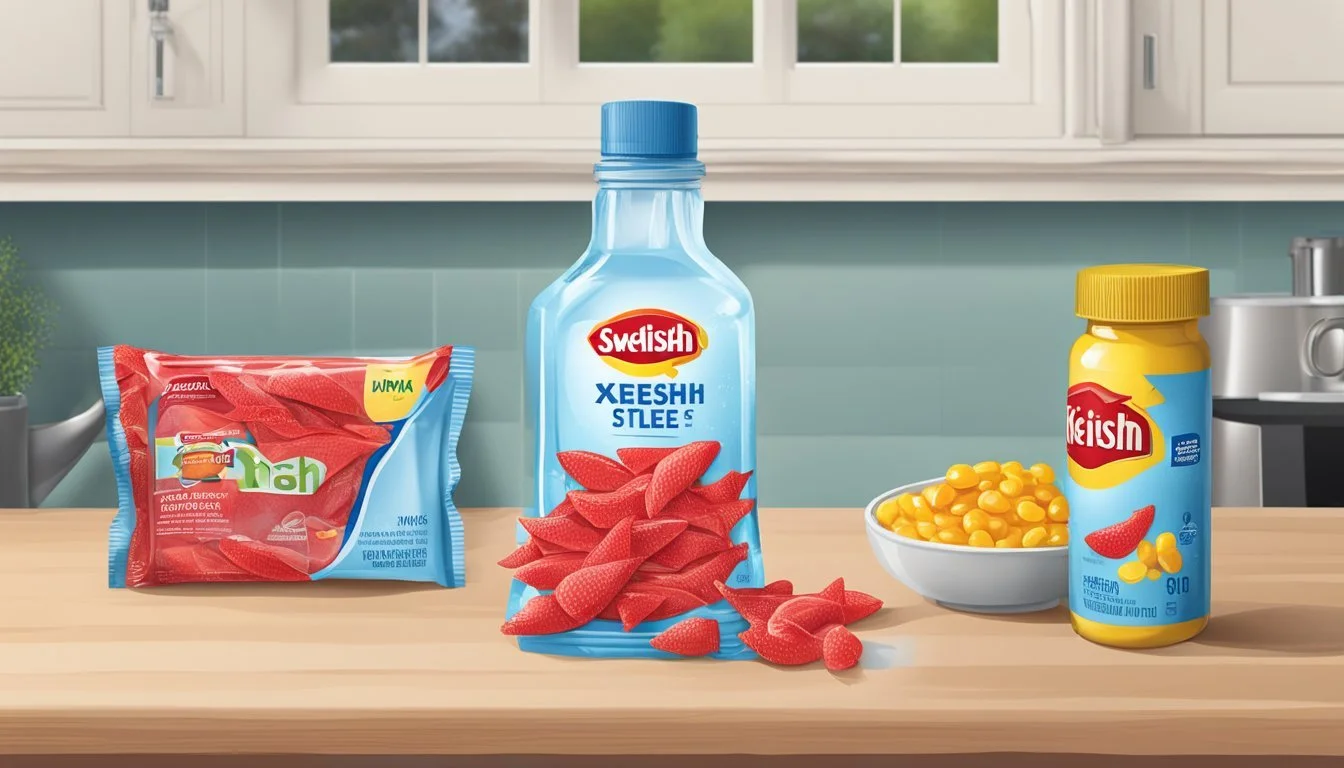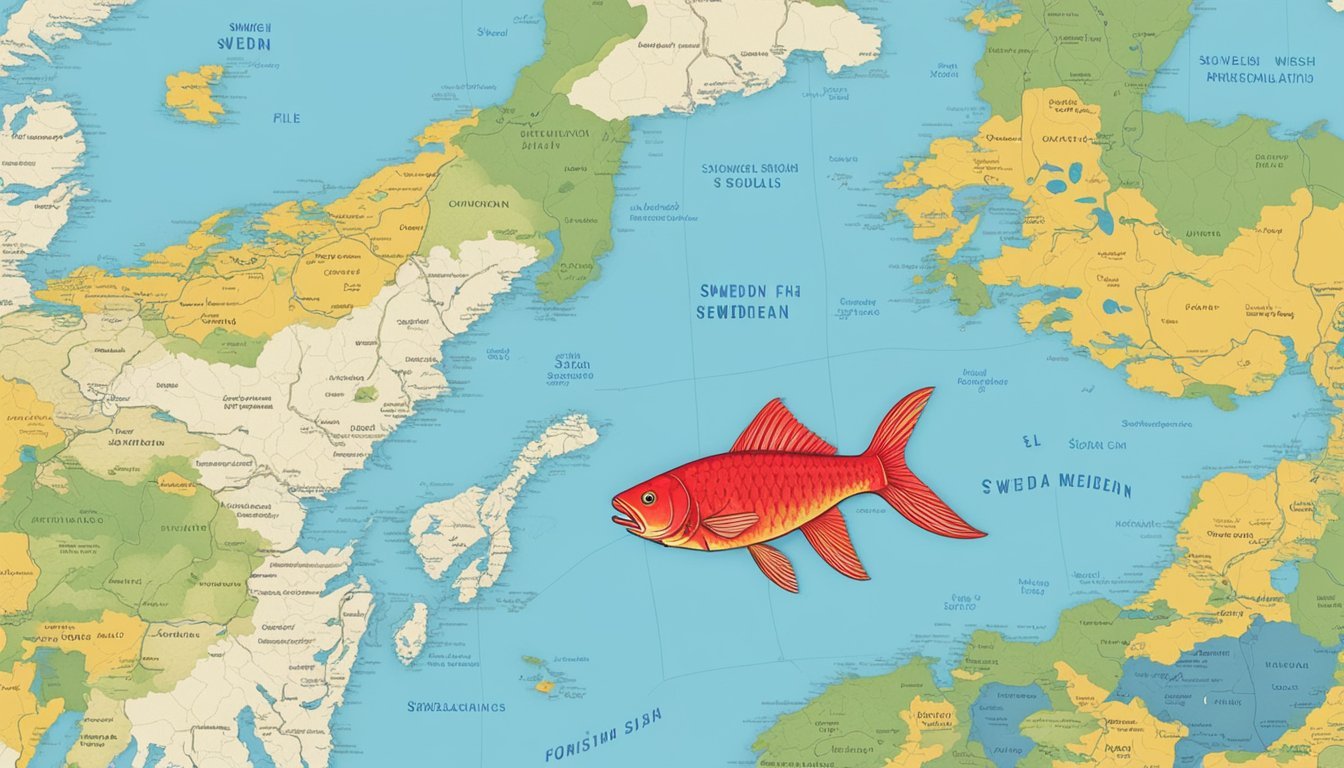How Long Do Swedish Fish Last?
Uncovering Shelf Life & Preservation Tips
Swedish Fish (how long does swedish fish last?), the chewy, fruit-flavored candy, have become a staple sweet treat enjoyed by many. With their distinct texture and bright red coloring, these gummy candies have been satisfying sweet tooths for generations. While they are typically consumed quickly after purchase due to their popularity, there are times when they sit on shelves or in pantries, leading consumers to question their longevity and how best to store them to maintain their quality.
The shelf life of Swedish Fish (What wine goes well with fish?) is quite impressive due to the high sugar (how long does sugar last?) content and lack of water activity within the candy, making it less hospitable for microbial growth. Unopened, they can last several months past the date indicated on their package when kept in a cool, dry place. Once opened, Swedish Fish continue to be safe for consumption but may start to lose their signature texture and flavor over time, especially if not stored properly.
Proper storage is key to extending the life of Swedish Fish. They should be kept in an airtight container to prevent them from drying out and becoming hard. Exposure to high temperatures or humidity can cause the candies to stick together or lose their shape, so it is recommended to store them away from these conditions. Despite their durability, enjoying them at their freshest is always the best way to experience their intended flavor and chewiness.
Overview of Swedish Fish
Swedish Fish are a renowned confectionery enjoyed for their unique texture and flavor. This section delves into their rich history, global popularity, and how the brand has evolved over time.
History and Origin
Swedish Fish were developed in the 1950s by the Swedish company Malaco. Intending to expand into the North American market, they designed these gummy candies to pay homage to Sweden's large fishing industry. Originally, Swedish Fish were red and had a flavor unique to the candy that many liken to lingonberry.
Popularity and Distribution
These chewy candies quickly gained popularity across North America. By the 1960s, Malaco partnered with Cadbury, and later on, Nabisco began distributing Swedish Fish in the United States. Today, various flavors and colors are available, and the candy is distributed not only in Sweden and North America but also in countries like Canada and Turkey.
Brand Evolution
Over the years, Mondelez International has become the current owner of the brand through various corporate acquisitions. Under their stewardship, Swedish Fish have maintained their iconic status while also undergoing changes such as new packaging designs, flavors, and even a vegan version of the candy to address diverse consumer preferences.
Swedish Fish Varieties
Swedish Fish offer an assortment of flavors and sizes that cater to various preferences, from the classic red to the multi-colored varieties.
Different Flavors
Original Red: Traditionally, the red flavor is ambiguous, often attributed to a berry or fruit punch flavor. The specific taste is inherently associated with just being "red".
Assorted Flavors: They include orange, lemon-lime, apple, and various berry flavors.
Swedish Fish Tails: A newer variety which combines two flavors into one piece.
Special Edition Flavors: Occasionally, limited-time flavors such as tropical fruit are introduced.
Shapes and Sizes
Classic Fish-Shaped: The original and most common format, imprinted with the word "Swedish".
Mini Swedish Fish: Smaller versions of the classic fish-shaped candies. They maintain the same flavor profile, only presented in a bite-sized form.
Swedish Fish Tails: These are designed with a dual-sided fish shape, showcasing a two-flavor combination.
Sweet Fish: This term is not specific to the Swedish Fish brand, but refers broadly to candy with similar traits, namely being chewy, sweet, and fish-shaped.
Ingredients and Nutritional Information
The ingredients in Swedish Fish and their nutritional profile are essential for consumers looking into their dietary impact. This candy's unique texture and flavor come from a specific blend of ingredients, while its nutritional content suggests moderate consumption.
Key Ingredients
Sugar: A primary component, providing the characteristic sweetness.
Corn Syrup (how long does corn syrup last?): Often used in confections to add sweetness and texture.
Citric Acid: Contributes to the tart flavor and acts as a preservative.
Natural and Artificial Flavors: These give Swedish Fish their distinctive taste.
Carnauba Wax/Beeswax: Used for coating to add shine and prevent sticking. Carnauba wax is used in candies manufactured in Canada, while beeswax is used in Turkish varieties.
Modified Corn Starch: Helps achieve the desired consistency.
Nutritional Content
Sugar Content: A 40-gram serving contains about 29 grams of sugar.
Protein: Less than 1 gram per serving.
Fat: Advertised as a fat-free food.
Dietary Fiber: Negligible quantities.
Iron: Not a significant source.
Caloric Information
A single serving size of 40 grams generally amounts to approximately 140 calories.
Allergens and Dietary Considerations
Gluten-Free: Swedish Fish do not contain gluten, making them suitable for people with gluten intolerance or celiac disease.
Vegan: As they do not contain gelatin, which is derived from animal tissues, Swedish Fish are considered vegan-friendly.
Allergens: Those with certain food sensitivities should note that these candies are produced in facilities that may also process allergens.
Packaging and Storage
When considering the longevity of Swedish Fish, packaging and proper storage are crucial for maintaining the candy's freshness and quality. These factors directly impact the shelf life and appearance, keeping the sweets from moisture and mold.
Shelf Life Determinants
Packaging: Swedish Fish are often sold in bags or boxes with a "best by" date, indicating when the candy should be consumed for optimum quality. The materials used for packaging are designed to protect the candy from external factors that could degrade its quality.
Shelf Life: Generally, Swedish Fish maintain their quality up to the expiration date as long as they are unopened and stored correctly. Once opened, they should be consumed within 7-10 days, especially if repackaged in a non-airtight container.
Storage Guidelines
Refrigeration: Not typically necessary for Swedish Fish, as it may alter the texture.
Freezing: Discouraged, as it can affect freshness and appearance, leading to a different mouthfeel upon thawing.
To maximize shelf life, Swedish Fish should be kept in a cool, dry place away from direct sunlight. If opened, transferring the candy to an airtight container can help maintain quality by minimizing exposure to air and moisture.
Consumption and Health
Consuming Swedish Fish as part of a diet can have varying implications on health, depending on frequency of intake and quantity. It is important for consumers to be aware of the potential health benefits and possible risks associated with the consumption of these candies.
Potential Health Benefits
Swedish Fish are a gluten-free candy, which makes them a suitable sweet treat for those with gluten intolerance or celiac disease. Additionally, for individuals following a vegan diet, Swedish Fish do not contain animal products, aligning with vegan dietary preferences.
Gluten-Free: Suitable for individuals with gluten sensitivities.
Vegan: No animal-derived ingredients.
Health Risks and Considerations
Despite the potential benefits for specific dietary needs, consuming Swedish Fish carries health considerations mainly due to their high sugar content. Regular consumption can lead to dental issues, such as cavities, due to sugar fostering an environment in the mouth that promotes tooth decay. They lack dietary fiber, fat, and iron, offering little in terms of nutritional value. Furthermore, they are not a sugar-free option, thus not suitable for a sugar-conscious diet or for those monitoring their blood sugar levels.
Teeth: High sugar content promotes tooth decay.
Iron, Fat, & Dietary Fiber: Lacks these nutrients, offering minimal health benefits.
Sugar: Not suitable for sugar-restricted diets.
Cultural Significance
Swedish Fish candy reflects not just a confectionery choice but resonates with elements of Swedish traditions and has extended its reach into global markets, influencing sweets culture internationally.
Swedish Fish in Swedish Culture
Swedish Fish, while developed for North American consumers in the 1950s by the Swedish company Malaco, connect to a broader tradition of sweets in Swedish culture. Gummy candies such as Swedish Fish align with Sweden's fondness for "lördagsgodis" or Saturday candy, a weekly tradition where children and adults enjoy sweets. On the more traditional side, Surströmming, a fermented herring dish, underscores the importance of fish and preservation techniques in the Swedish diet.
Global Influence and Collaborations
The brand's global influence is notable, particularly after Cadbury Adams—a subsidiary then of Cadbury, now part of Mondelez International—took over the distribution of Swedish Fish in North America. Furthermore, strategic collaborations have expanded the candy's appeal. Maynards, a Canadian confectionery, and Rita's Italian Ice have included Swedish Fish flavors in their offerings. Even IKEA, globally recognized for its furniture, contributes to the candy's international presence through its marketplace, selling Swedish Fish within its assortment of Swedish food items. It epitomizes how a simple candy can become an icon of both a nation's cultural heritage and its commercial export.
Industry and Market
The Swedish fish market demonstrates a robust demand for seafood, with both fresh and confectionery forms of "Swedish Fish" being notable for their prevalence in retail environments.
Consumer Demand
Consumers in Sweden exhibit a steady appetite for fish and seafood, and this extends to the popular gelatin-free candy known as Swedish Fish. The demand for these fish-shaped confections reflects Sweden’s broader trend of high confectionery consumption. Consumers seek these candies for their unique flavor and consistency. They are commonly found in grocery stores and are a staple in the candy aisles, often associated with Swedish identity and nostalgia.
On the seafood front, there is an increasing consumer inclination toward sustainable and locally sourced fish, influencing purchasing decisions. Sweden’s imports of fish and seafood have shown growth, indicating not only a domestic demand but also a diverse palette for various fish and seafood products.
Retail Presence and Availability
Swedish Fish, the candy, are widely available in various retail settings, ranging from convenience stores to grocery stores. They typically come in an assortment of sizes and packaging options, extending from small bags for individual consumption to bulk packages for parties or events.
As for fish and seafood products, their presence is strong across retail platforms. Grocery stores are the primary source for consumer purchase of fish, offering a range of fresh, frozen, and processed seafood. The availability of these products is indicative of the high consumption rates of fish in Sweden, with stores consistently stocked to meet customer demand.
The fish and seafood sector in Sweden not only caters to consumers' appetites but also contributes significantly to the industry’s turnover, with the annual turnover of fish sales reaching into the billions of Swedish kronor, underscoring the market's vitality.
Product Variations and Innovation
Swedish Fish has evolved over the years, incorporating diverse product variations and innovative collaborations that have broadened its appeal. This section dives into the specifics of these partnerships and the expansion of dietary-options in the product line.
Collaborations and Spin-offs
Swedish Fish has engaged in strategic collaborations to create new and exciting products, expanding their market reach beyond traditional candy aisles. For instance, in a co-branding venture, Oreo, a cookie brand owned by Nabisco, introduced a limited edition Oreo cookie with a Swedish Fish flavored crème filling, combining the iconic flavors of both snacks. This bold fusion was met with mixed reactions, but it undeniably showcased Swedish Fish's willingness to innovate.
Another inventive spin-off involved a partnership with Trident, a popular chewing gum brand, which integrated the distinct taste of Swedish Fish into a gum product. This allowed the candy's distinct flavor to be enjoyed in a long-lasting, chewable format.
Dietary Options
Swedish Fish acknowledges the diversity in consumer dietary needs and preferences. They have expanded their offerings to cater to a broader audience, including:
Vegans: Swedish Fish are widely recognized as a vegan-friendly confection because they do not contain gelatin, which is common in many gummy candies.
Sugar-Free Options: As consumers become more health-conscious, there is an increasing demand for sugar-free alternatives. Swedish Fish has responded by creating sugar-free versions of their candy, providing an option for those looking to reduce their sugar intake.
Furthermore, Swedish Fish has been utilized in various other food products. For example, the candy has been incorporated into an ice cream flavor by the ice cream brand Rita's based in Hamilton, Ontario, thereby innovating within the frozen dessert market and reaching new customers. This variety suggests a commitment to innovation and adaptation in line with changing consumer tastes and health trends.
Marketing and Advertising
Swedish Fish has maintained a strong market presence through consistent branding strategies and advertising campaigns that resonate with consumers across various platforms.
Branding Strategies
Cadbury Adams and later Maynards have owned and marketed Swedish Fish, utilizing distinct branding strategies to position the candy in the market effectively. The branding leverages the unique shape of the fish, synonymous with the product, to create a memorable visual identity. Product diversifications such as Swedish Fish Tails, Giant Fish, and the introduction of new flavors like grape, strawberry, and lingonberry have kept the brand fresh and topical.
Advertising Campaigns
Swedish Fish advertising campaigns frequently employ a mix of traditional and digital media to reach a broad audience. They have partnered with companies like Rita's Italian Ice to create co-branded products, thus expanding their market reach. Online marketplaces such as Amazon have facilitated targeted advertising and accessibility, allowing the brand to tap into a larger pool of potential customers. Whether through starch jellies beguiling in commercials or captivating graphics on social media, their advertising consistently highlights the fun and flavor of the candy.









